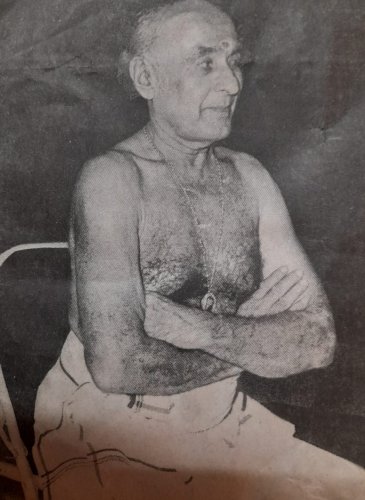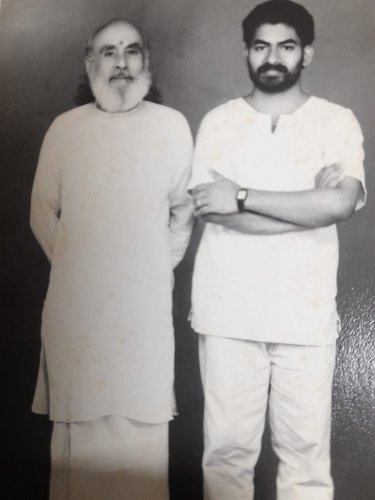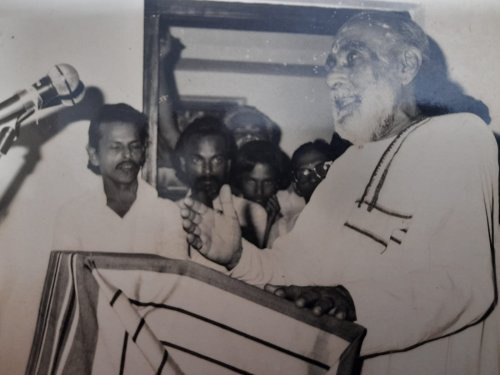
|
 |

|
 |
An imaginary interview with Guru Gopinath - Part 13 - Tapati Chowdhurie e-mail: tapatichow@yahoo.co.in Photos courtesy: Sashimohan July 26, 2022 All parts of the interview The 13th and final part of the imaginary interview  Master, what are the Kathakali veshams you performed after becoming a dancer? At the request of Poet Vallathol Narayana Menon, I performed in the role of Duryodhana in Utthara Swayamvaram in full Kathakali vesham at the literary conference (Sahithya Parishad Sammelanam) in Kizhuthani. I performed in the birth centenary celebrations of Mathur Kunju Pillai Panicker aasan at Nedumudi Kottaram (palace). On the Chairman of Kerala Kalamandalam D.H. Nambudirippad's request, I performed in Kerala Kalamandalam. At the request of Abhedanandaswamy I performed in his ashram in Thiruvananthapuram. I have also performed at a program in the Kathakali club of Thiruvananthapuram and at the Karthika Thirunal theatre on the request of TR Sukumaran Nair. I did the role of the handsome Brahman (Sundara Brahmanan) of Rukmini Swayamvaram. All in all, I have performed five times in Kathakali veshams. Though many a times I have been invited for a Kathakali show, I haven't accepted those requests. Why didn't you accept the request to perform as a full fledged Kathakali dancer, though you were trained to be one for 12 long years? The main reason why I refused to take part in a pure Kathakali presentation is that starting from 1931, I have been adopting a different style from the actual discipline of Kathakali, starting from the body (anga vinyasam) movements and hand gestures, costumes, instruments and presentation style, though I have not forgotten the Kathakali I learnt 53 years back. But if I perform Kathakali now, there would be a mixing of my new and old style of practice. It might not be pleasing to the audience.  With Sahiduddin from Bangladesh, his last foreign student In your new form have you deviated from the cannons laid down in Natya Shastra? In my new form of dance style I have been consciously aware of presenting Nritta- Nritya- Natya by choosing appropriate hand and feet movements, anga vinyasas, storyline, characters from traditional Kathakali and have merged it with the Bhava- Raaga - Taala - Melam - Dhwani, according to the rules of Natya Shastra. And I am not willing to abandon this and switch to the traditional form that I have learnt. I came to be well known as an artiste through my innovative movements and all the comforts and honours that I have received in my life was through this new style. Tell us about your meeting Ragini Devi again after leaving her troupe. After leaving Ragini Devi's group in 1935, I met her again in 1958 at Indrani Rahman's residence at Sujan Singh Park, Shahjahan Road, Delhi. We both were overjoyed to meet each other. She spoke appreciatively of my artistic qualities and congratulated me. I confessed respectfully that it was through her help that I could master it all. We recalled at length all our past experiences after we had parted company to follow our dreams. Her daughter Indrani (the kid I raised for 2-3 years) has become a famous dancer. Ragini Devi, Indrani, her husband Habib Rahman and I partook of the grand meal they had prepared and we spoke on many matters. I invited them to my house whenever they came to Madras. About two months later I came to know that Indrani had joined Pandanallur Chokkalingam Pillai's school in Egmore, Madras to study Bharatanatyam. One day I went to her place and invited her to my house. She said that her mother Ragini Devi would be travelling to Madras from Bombay soon and Rahman would also be joining her. So she promised to come with her mother and husband to my house. Accordingly, six days later, the three of them became our guests and stayed with us in Natana Niketan. Ragini Devi saw our house in Madras and said, "I am trying since 1930 to build a house in Bombay but am not successful but Gopinath, you have made not one but two houses here. How did you arrange the money for this? Lucky man!!" I replied, "Ragini Devi, when you got Rs.100, you spent the 100 and an additional 50 by taking a loan. But when I got Rs.100, I spent only 60. My wife also has the same habit. I believe that a person who cannot live on a meager expenditure cannot save money." They left for Delhi after staying with us for three days. I can never forget that it was Ragini Devi who transformed me into a dancer. She published 2 books 'Nrithanjali' and 'Dance Dialects'. She passed away on Jan 23, 1982 back in New York. Not many know the fact that the spread of Indian dance, especially Kathakali began to gain popularity after Ragini Devi came to study in Kalamandalam. I have no doubt that till I can remember; I will always remember her contribution respectfully. Who are those who were in a position of power who helped you? In my life until now, many well wishers who were both great and not so great have encouraged me and helped me. Among them some are no more. It would be ungrateful of me not to mention at least a few… although I cannot mention all I will mention a few. I will never forget the help and cooperation of G.P. Shekhar who passed away on 5th July 1984. He was the reason behind me performing in the palace in Thiruvananthapuram, becoming a palace dancer and starting a dance school. I am deeply saddened by the death of my dear friend who helped me to raise the standard of living as an artiste. In fact, I felt as if my right hand stopped working. I was lucky to have his friendship from 1933 until 4th July 1984. Similarly, K.C. Pillai whom I first met at Santiniketan on 27th January 1935 continued to be my well-wisher, family friend and a decent and respectable person. Mahakavi Vallathol, Mukundaraja, Sardar K.M. Panicker, Dr. K.C. Panicker, G. Venkatachalam, Malayalam Raajyam editor K.G. Shankar, Raama Varma Thamburan, V. Krishnan Thambi, Dr. Cousins, Dr. K.N. Pisharody, Pattamthaanu Pillai, Dr. Marthanda Pillai (Madras), Dr. C.R. Krishna Pillai (Madras), K.P. Keshava Menon (Kozhikode), A.N. Thambi, New Theatre P Subramaniam, Film Director K Subrahmanyam, D.H. Nambudirippad, Karthyayani Amma of Thiruvananthapuram Malaya Cottage, S. Chidambaram (Madras), Former Chief Minister R. Shankar, Kerala Kaumudy K. Sukumaran, Mannathu Padmanabhan are all the people - who are no more - who were very interested in my welfare. The list includes M.K.K. Nair, M.N. Parameshwaran Pillai, Rosekkottu Krishnapillai, E.M.S. Namboodiripad, C. Achutha Menon, P.K. Vasudevan Nair, E.K. Nayanar, K.R. Pisharody, Janaki Ammal (Madras) who love me as an artiste. Other than that I have been able to be friends with many great personalities from different parts of India. And I pay my respects to all the great artistes who are no more as well as those who are still alive. What were some of the die-hard habits of your life? I hated procrastination and was very careful about completing the day's work as much as it was physically possible. Maintaining punctuality was in my blood; leading a simple life was my obsession; enthusiasm about any work regarding my artistic pursuits and agriculture was close to my heart. In the last 61 years, whether I am taking a journey by bus, train or flight, it has been my habit to reach at least half an before the actual time of departure. Ever since I went to Mookambika temple at the age of nineteen and had a darshan of the goddess, it has been my habit to pray to her for forty minutes. Whether I am in India or abroad, I have strictly followed this routine. I have firm belief that I will continue this routine for the rest of my life. Who were some of the fellow dancers who have contributed to your growth? I would be doing a great wrong if I fail to mention two of my fellow dancers, who have contributed to my artistic growth and development. Ragini Devi, an American woman, was the first to recognize my talent and transform me into a dancer from just being a mere Kathakali artiste. She was a famous dancer who learnt Indian dance and understood the rules of the Natya Shastra and used it in her own way. In fact, I still consider her as my Guru. I would not have been able to become a dancer had I not met her. I pray for the eternal peace of her soul. The second is my dance partner and life partner Thangamani. Nala needed the help of a swan to marry Damayanti. I have written earlier about the divine help I received from Goddess Saraswati to marry Thangamani. She deserves to be known as the best dancer. I trained her only for a few days after marriage and of course due to her hard work and passion for dance she became an accomplished dancer. I came to be known as an artiste after a training of 12 years. Thangamani acquired the title as an artiste in 2 years and 2 months. This was possible due to her abundance of talent. She possesses the heart and body of a dancer. I have given only some instructions to her on her dance practice. She had all the qualities of a dancer and I am also proud to say that God has given her all the virtues of being a wife. I have not seen a dancer of this generation in Kerala who can equal Thangamani in angika, vachika, aharya, sattvika abhinaya and Shakhango upanga vinyasa. Some readers may think that I am praising her because she is my wife, but there is no point in not being honest about the truth. I can say that it was due to Thangamani's support and hard work that we had a comfortable and prosperous family life too. I had mentioned before that my bank balance at the time I got married was a mere 11 annas. At 66 years of age, Thangamani is still working tirelessly to improve the quality of our lives and I fully believe that her intelligence and hard work will enable her to be wealthy enough to sustain her and see her through for the rest of her life. Tell us about yourself in brief, Guruji. Born in a house surrounded by water on all 4 sides in Kuttanad, I did my schooling until 5th grade in Malayalam, learnt Kathakali, an art form that no one wanted to at that time, developed a different Nritta-Nritya-Natya style from that, exhibited the art and art form to different parts of the world. I firmly believe that I was able to attain fame, glory, status, degrees and a comfortable family life by being controlled by some divine force.  Speaking on the occasion of releasing his autobiography When did you start writing this autobiography? Though I started writing this autobiography on 15th April 1979 at the request of my eldest daughter Vasanthi in Los Angeles, I could complete it only two weeks after 19th July 1984 when I was staying with my second daughter Vilasini at her workplace, in Surat. I have written in this autobiography 90 percent of my life incidents from 5 years to 76 years of age. My lifelong friend, Nagavalli R.S. Kurup has checked and corrected the mistakes in my language and made the necessary changes to make the text beautiful. I am not sure how I will thank him. I pay my respects to him with folded hands. "Angam galitham palitham mundam Dasanavihinam jaatham thundam Vriddho yathi gruhithva dandam Thathapi na munjathyasapindam" I ended this retrospective by quoting and remembering the human condition given in the famous kriti of Shri Shankaracharya, spending more time in remembrance of God, reminiscing about the past.  Guruji hours before his death  Tapati Chowdhurie trained under Guru Gopinath in Madras and was briefly with International Centre for Kathakali in New Delhi. Presently, she is a freelance writer on the performing arts. Post your comments Please provide your name and email id when you use the Anonymous / blog profiles to post a comment. All appropriate comments posted with name and email id in the blog will be featured in the site. |